[Next] [Previous] [Top]
`16-19 Mathematics' - A new level A level course in the UK
Chris Belsom
Ampleforth College
York, UK
Introduction
16-10 Mathematics is a major new course for post 16 mathematics education in the UK. It was developed by the School Mathematics Project in the latter part of the 1980's by teams of practising teachers under a full time project director (Dr. S.W. Dolan) based at the SMP offices in Southampton. The development work took place over a period of about 5 years with extensive trailing of material in schools. The project, with its innovative assessment structure, was accepted by the School Curriculum and Assessment Authority (SCAA) for national trials in 30 schools (approximately 1000 students). The three year national trial led to a number of modifications to the scheme and the material before it was finally launched in 1991. The course has proved very popular with teachers and students alike, and uptake has been very rapid, with about one fifth of the total A level cohort in England now entering for its examinations. The course is fully supported with material written by the 16-29 writing teams and published by Cambridge University Press.
Why 16-19 Mathematics?
Mathematics is compulsory element of the National Curriculum in England and Wales up to the age of 16. Those who stay on in schools and colleges to take A levels choose the subjects that they wish to study in the `Sixth Form'. The proportion of A level students choosing to study mathematics at this level has steadily declined over many years (Figure 1) and both teachers and universities were expressing considerable anxiety about the causes of such a decline, and the consequences! Of the students who did take mathematics at A level there was both a very high fall out rate from the courses and a high failure rate in the examinations at the end of the course.
Students were achieving little success - other subjects were perceived as being easier - and so they voted with their feet and elected to study something else. Mathematics needed an injection of new ideas at this level and a radical rethink about the nature of the curriculum and assessment structures.

Figure 1
At the same time their was a quantum leap in available calculator technology which meant that relatively affordable calculators could plot graphs, do numerical calculus and were easily programmable. Computers were also becoming more accessible and easier to use. The advances in technology cried out for exploitation within the mathematicals syllabus. Equally important, the new National Curriculum (NC) in Secondary schools did not match well with established A level courses. Coursework, for example, was a feature of the NC courses and students and teachers felt it was appropriate that it should also be a feature of A level courses. At the time it was not.
The 16-19 Mathematics Project was established to consider these problems and to construct a new A level course which would seek to address these and other issues. The stated aims of the course are listed below.
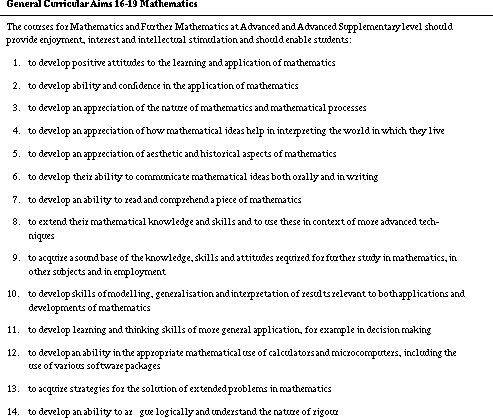
Note the clear statement of intent in relation to the use of calculators and computers (12), the emphasis on more general skills (1, 7, 11, 14) and on mathematical modeling (10).
Content
The syllabus is essentially based on traditional subject content (with some notable extensions - see Figure 2, the course structure diagram below). However, there was to be a far greater emphasis on core skills and on mathematical modeling. Graph plotting and programmable calculators were to be integral to the development of the ideas and students would be assumed to have such calculators available. Although there are themes running through the course, the course was constructed on subject grouping and not thematically. Traditionally in the UK `Applied Mathematics' is an accepted part of any A level course, and it was decided very early in the development that the new 16-19 course would contain compulsory elements of both Statistics and Mechanics, as well as other areas of applied mathematics.
Course Structure
The chart below (Figure 2) illustrate the overall structure of the course, including the structure of the Advanced and Advanced Supplementary courses in Further Mathematics.
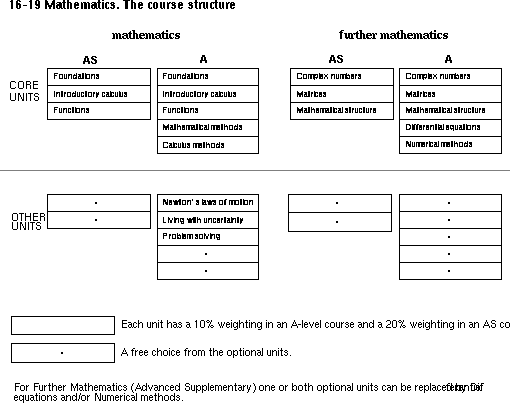
Figure 2
A radical departure from conventional courses at the time was to structure the 16-19 course into ten course units. Eight of the units were to be compulsory and two were to be optional. The compulsory units contained all of the Pure Mathematics in the syllabus (5 units), one of Mechanics (Newton's Laws), one of Statistics (called `Living with Uncertainty'!) and one, Problem Solving, was to develop and assess a number of mathematical problem solving skills. As this is a rather unusual unit, I list its Aims and Objectives below.
Problem solving
This is a compulsory unit for Mathematics (Advanced).
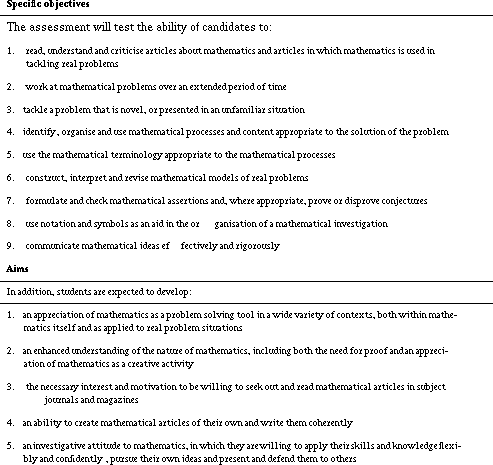
While the course is not thematic, there are very important themes running through it. The inter relationship of the geometry of transformations, graphs and algebra is one such theme. This helps in visualising the graphs of functions, and helps explain many calculus results for example, as students consider the effect of the transformations on the gradient of the function. Similarly the idea that ex and lnx are inverse functions and their graphs are reflections in the line y=x, is exploited to good effect in the Student Tasksheet (Worksheet) below (Figure 3) where the gradient of lnx is being found. These are very revealing insights for students and certainly worth taking time over in the course. Linking ideas in this way is a crucial part of the effective learning of mathematics and is very likely to make the ideas more permanent than they would otherwise be.
Having curricular materials which stress such links is also helpful to teachers who might not otherwise give them the emphasis they deserve.
Tasksheet from the Unit on Introductory Calculus
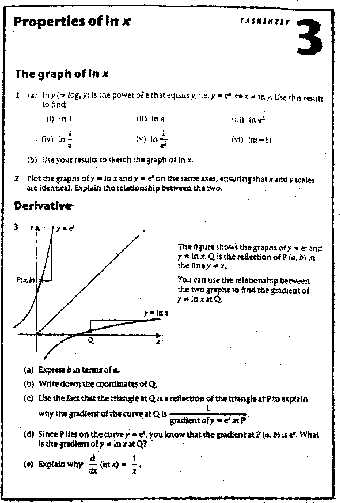
Figure 3
Learning Styles
The course is adaptable in the way it can be used in the classroom, and has been developed to foster a variety of possible teaching and learning styles. A key feature of the way the material is written is the emphasis on the need for the student to take some active (and consequently more effective) part in the development of ideas, rather than simply regurgitating ill formed and misunderstood notions. This brief is taken up by Tasksheets. These are written into text and are a major part in the students learning process. They are designed to be worked through by the student who explores a number off-key ideas prior to the topic being more formally addressed in the text. Figure 3 above is a typical example of such a Tasksheet. There is a significant emphasis on coursework within the teaching and learning structure of the course. Students have to write up the results of their own investigations on such diverse problems as, `An analysis of a tennis serve', `A statistical investigation of authorship', `Planetary Motion' etc. etc. Such investigations allow the student to work independently (or in groups) over a longer period of time, to develop and follow up ideas, and to write up their own work in a way which will be understood by others to communicate effectively within a mathematical context.
The influence of Calculators/Computers
16-19 Mathematics was written with the graphical calculator very much in mind. The zoom facility of the graph plotting calculator gave us the opportunity to adopt a radically different approach to the initial development of the calculus, where the concept of local straightness is employed to good effect in finding gradient functions prior to more traditional formalization. Students are also encouraged to program their calculators whenever possible and most become rather adept at it! Support material which encourages this process is provided both within the text and on various Tasksheets.
A support resource sheet for calculator use
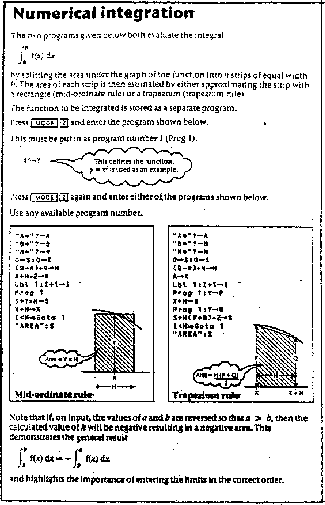
Figure 4
Assessment Structure
The assessment procedures of the 16-19 Mathematics courses are highly original and have proved to be very effective. At the time at which 16-19 Mathematics became available in the early's 1990's the accepted A level assessment was the final 3 hour examination (normally two such papers) assessing material studied throughout the full two years of the course. The 16-19 scheme adopts the principle of fitness for purpose, where, as far as is possible, methods of assessment have been chosen to support the curricular aims of the course. Experience has shown that unless assessment procedures underwrite desired changes in approach, then teachers and students are less than willing to engage in them. For example, as well as aiming to foster the students use of technology we also have sought to assess a students ability to mark upon extended pieces of work - which require the collection of data perhaps, and the formulation and testing of conjectures. Similarly we encourage students to read and write in a mathematical context. Traditional timed written papers, although valuable and employed to good effect in the course assessment, are not the most appropriate form of assessment for such skills.
The assessment details are listed below.
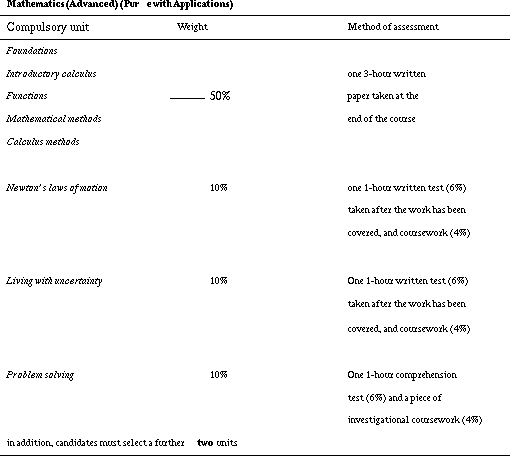
Essentially the five compulsory units in Pure Mathematics are assessed by a 3 hour examination at the end of the course. Each of the other 5 units is assessed by a combination of a 1 hour test (set externally by the Examination Board) which is weighted at 60%, and one or two small pieces of coursework (40%). The end of unit tests as they are called, are taken at a convenient time of the schools choosing during the course, normally as soon as the unit is completed. Students are not allowed to retake unit tests - the scheme is not a modular one where this would be possible.
These short term goals have proved very motivating for students and have been a very effective way of encouraging students to stay with the course - as a consequence the drop out rate has been reduced dramatically.
Has it worked?
There are encouraging signs! The assessment structure and the short term goals have certainly raised performance and improved grades achieved. Students appear to enjoy the course - it is very popular. It is fair to say that the course offers hard working students a fair chance of some success and is consequently able to offer rewards commensurate with ability such as the conventional A level Mathematics often was not - especially for the weaker student. Teachers talk highly of the course and assessment structure and of the variety of support material available to them. For myself I can certainly vouch for its success. In my own school the numbers of students choosing to take mathematics at A level has increased each year since introducing the 16-19 course - from 28 just before we started the scheme, to 70 this year. A dramatic growth of interest in only four years! These students are likely to benefit in their further studies or fields of employment - possible many will even consider going on to read mathematics at university.
Further details about the 16-19 course are available from:
School Mathematics Project
The University
Southampton SO17 1BJ
England
email: 101630.165@compuserve.com
ICME8 - WG13 - 02 JUL 96
[Next] [Previous] [Top]
Generated with CERN WebMaker







